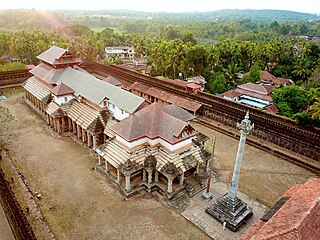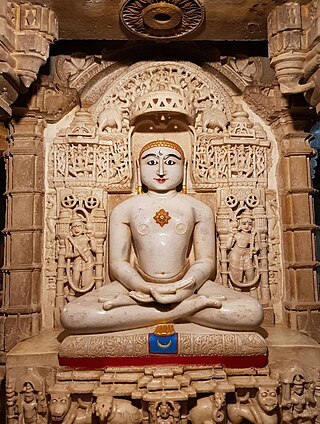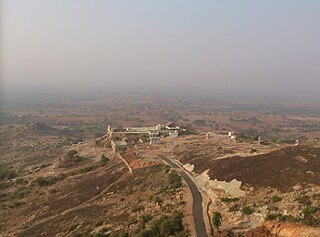
Shravanabelagola is a town located near Channarayapatna of Hassan district in the Indian state of Karnataka and is 144 km (89 mi) from Bengaluru. The Gommateshwara Bahubali statue at Shravanabelagola is one of the most important tirthas in Jainism, one that reached a peak in architectural and sculptural activity under the patronage of Western Ganga dynasty of Talakad. Chandragupta Maurya is said to have died here in 298 BCE after he became a Jain monk and assumed an ascetic life style.

Padmāvatī is the protective goddess or śāsana devī (शासनदेवी) of Pārśvanātha, the twenty-third Jain tīrthāṅkara, complimenting Parshwa yaksha in Swetambara and Dharanendra in digambar the shasan deva. She is a yakshini of Parshwanatha.

Humcha / Hombuja is a small village near Ripponpet, Hosanagara taluk in Shimoga district in the Indian state of Karnataka. Humbaja Atishaya Jain Teerth Kshetra is famous for being home to an ancient temple of Goddess Padmavati, and to the Humbaj Matha (seminary/monastery), an important institution of the Jain community. This temple is considered to be very holy and is known for its cultural and historical heritage. Other notable highlights of the place are a lake that reputedly never dries up and a tree that likewise always remains green.

Karnataka, a state in South India has a long association with Jainism, a religion which enjoyed patronage of major historic kingdoms in the state such as the Rastrakuta Dynasty, Western Ganga, Kadamba and Chalukya dynasties and the Hoysala Empire. Today the state is home to a number of Jain monuments, such as temples, Gommata statues and stambhas.

Chandragiri is one of the two hills in Shravanabelagola in the Indian state of Karnataka, the other one being Vindhyagiri. It is also near Indragiri.

Saavira Kambada Temple or Tribhuvana Tilaka Cūḍāmaṇi), is a basadi or Jain temple noted for its 1000 pillars in Moodabidri, Karnataka, India. The temple is also known as "Chandranatha Temple" since it honours the tirthankara Chandraprabha, whose eight-foot idol is worshipped in the shrine.

Jainism in North Karnataka flourished under the Chalukyas, Kadamba, Rashtrakutas, and Vijayanagara empire. Imbued with religious feeling, patronage was extended towards the building of Jain temple and it garnered high repute among the people, particularly the ruling classes and the mercantile community; effectively getting treated as the state religion.

Akkana Basadi is a Jain temple (basadi) built in 1181 A.D., during the rule of Hoysala empire King Veera Ballala II. The basadi was constructed by the devout Jain lady Achiyakka, wife of Chandramouli, a Brahmin minister in the court of the Hoysala king. The main deity of the temple is the twenty-third Jain Tirthankar Parshwanath. The temple is protected as a monument of national importance by the Archaeological Survey of India. It is part of an Archaeological Survey of India Adarsh Smarak Monument along with other temples in the Shravanabelagola group of monuments.

Chandraprabha or Chandranatha is the eighth Tirthankara of Tīrthaṅkara of Jainism in the present age. According to traditional accounts, he was born to King Mahasena and Queen Lakshmana Devi at Chandrapuri to the Ikshvaku dynasty. According to Jain texts, his birth-date was the twelfth day of the Posh Krishna month of the Indian calendar. He is said to have become a siddha, a liberated soul which has destroyed all of its karma.

Guru Basadi is a basadi or Jain temple located in Moodabidri town in the Indian state of Karnataka. The Guru basadi is the oldest amongst 18 Jain basadis in Moodabidri built in 714 CE. This temple is near another Jain temple, Saavira Kambada Basadi.

Chaturmukha Basadi is a symmetrical Jain temple situated in Karkala, Karnataka, India. It is one of the most famous monuments in Karkala.

Kanakagiri Jain tirth kshetra also known as Kanakadri and Hemantha Desha is situated at about 3 km from Maleyuru, Chamarajanagar district, 53 km from the Mysore city and 182 km from Bengaluru.

Jain Basadi complex in Halebidu, Hassan district consists of three Jain Basadis dedicated to the Jain Tirthankars Parshvanatha, Shantinatha and Adinatha. The complex is situated near Kedareshwara temple and Dwarasamudra lake. These temples were constructed in the 12th century during the reign of Hoysala Empire along with Kedareshwara temple and Hoysaleswara Temple have been proposed to be listed under UNESCO World Heritage Site. The temple complex also includes a step well called Hulikere Kalyani.
Shri Atishaya Kshetra Simhanagadde Jwala Malini Digambar Jain Temple or Atishaya Shri Kshetra Simhanagadde is a famous Jain temple in Narasimharajapura of Chikmagalur district in Karnataka.

Santara or Bhairarasa is a medieval ruling dynasty of Karnataka, India. The area covered by their kingdom included territories in the Malenadu region as well as the coastal districts of Karnataka. Their kingdom had two capitals. Karkala in the coastal plains and Kalasa in the Western ghats. Hence the territory they ruled was also known as the Kalasa-Karkala kingdom. The Santaras were Jains and had matrimonial relations with the Saivite Alupa royal family. The Santaras became the feudatories of the Vijayanagara Empire after its rise. During this period, the Santara ruler Veera Pandya Bhairarasa erected the monolith of Bahubali in Karkala. The dynasty passed into oblivion after invasions by the Nayakas of Keladi and later by Hyder Ali

Kere Basadi or Chaturmukha Basadi is a Jain temple located in Varanga village in Udupi district of Karnataka, India. This 12th-century temple is situated amidst of a lake giving it the name Kere Basadi. The temple is also known Chaturmukha Basadi as it houses a chaturmukha (four-faced) idol of tirthankaras. The temple is situated 26 km from Karkala, another popular Jain centre.

The Lakshmeshwara Jain temples is a group of Jain temples in the town of Lakshmeshwara in the Gadag district of Karnataka.

Gommateshwara statue, Karkala is located at Karkala in the state of Karnataka. It is the second tallest statue of Bahubali in the world with the largest statue located at Shravanabelagola.

Parshvanatha Basadi or Kamatha Parshvanatha Basadi is a Jain temple (basadi) located on Chandragiri Hill in Shravanabelagola, a town in Karnataka, India.

Bhandara Basadi or Chaturvimsati Tirthankar Basadi is a Jain temple (basadi) built in located in Shravanabelagola, a town in Karnataka, India.






















